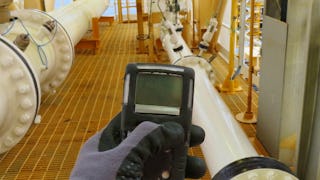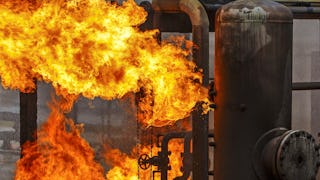This course aims to provide process safety experience for engineers, particularly relevant to chemical engineering but applicable to any field involving process operations. This course introduces you to the important, practical, value-added skills and information that will aid your career, or preparation for a career, in chemical process engineering. These skills include improving your ability to identify and quantify toxic chemical hazards and be able to identify and mitigate scenarios where reactive chemical hazards are present. You will be able to describe the importance of pressure protection and the general process for pressure relief system design all while using lessons learned from past chemical process incidents to inform the implementation of safer solutions and work practices.

Enjoy unlimited growth with a year of Coursera Plus for $199 (regularly $399). Save now.

Chemical Hazards: Toxicology & Reactivity
This course is part of Chemical Hazards and Process Safety Specialization

Instructor: Jason White
5,404 already enrolled
Included with
(56 reviews)
Recommended experience
Skills you'll gain
Details to know

Add to your LinkedIn profile
4 assignments
See how employees at top companies are mastering in-demand skills

Build your subject-matter expertise
- Learn new concepts from industry experts
- Gain a foundational understanding of a subject or tool
- Develop job-relevant skills with hands-on projects
- Earn a shareable career certificate

There are 4 modules in this course
After this module, you will be able to define industrial health and hygiene including important regulatory agencies. You'll be able to describe chemical hazards and the importance of understanding these hazards. You will be able to describe how chemical reactions, when not managed properly, can result in catastrophic scenarios. Finally, you will be able to use the Globally Harmonized System (GHS) for Safety Data Sheets and Labels as well as the National Fire Protection Association (NFPA) diamond.
What's included
7 videos1 reading1 assignment2 discussion prompts
After this module, you will be able to define, discuss, and use exposure limits such as threshold limit value (TLV) and permissible exposure limit (PEL). You will be able to describe effects of toxicants and quantify impact of exposure using dose versus response curves. You will be able to describe control techniques to prevent exposures, as well as use lessons from past chemical process safety incidents to inform the implementation of solutions and work practices.
What's included
6 videos1 assignment2 discussion prompts
After this module, you will be able to identify processes and situations where reactive chemical hazards are likely to be present. You will be able to create and use a chemical compatibility matrix. And finally, you will be able to describe how to use calorimeter data to characterize chemical reactions.
What's included
8 videos2 readings1 assignment1 discussion prompt
At the end of this module, you will be able to explain the importance of pressure protection and define key terms related to pressure relief devices. You will be able to identify major classes of relief devices and be able to describe options for handling relief effluent. Finally, you'll be able to describe the general process for relief system design.
What's included
7 videos1 assignment2 discussion prompts
Earn a career certificate
Add this credential to your LinkedIn profile, resume, or CV. Share it on social media and in your performance review.
Instructor

Offered by
Explore more from Chemistry
 Status: Free Trial
Status: Free TrialUniversity of California, Davis
 Status: Free Trial
Status: Free TrialUniversity of California, Davis
 Status: Free Trial
Status: Free TrialUniversity of California, Davis
 Status: Free Trial
Status: Free TrialUniversity of California, Davis
Why people choose Coursera for their career




Learner reviews
56 reviews
- 5 stars
80.35%
- 4 stars
14.28%
- 3 stars
5.35%
- 2 stars
0%
- 1 star
0%
Showing 3 of 56
Reviewed on Nov 26, 2025
this course is so valuable , it add more information to my knowledge that will be used in advancing my career
Frequently asked questions
To access the course materials, assignments and to earn a Certificate, you will need to purchase the Certificate experience when you enroll in a course. You can try a Free Trial instead, or apply for Financial Aid. The course may offer 'Full Course, No Certificate' instead. This option lets you see all course materials, submit required assessments, and get a final grade. This also means that you will not be able to purchase a Certificate experience.
When you enroll in the course, you get access to all of the courses in the Specialization, and you earn a certificate when you complete the work. Your electronic Certificate will be added to your Accomplishments page - from there, you can print your Certificate or add it to your LinkedIn profile.
Yes. In select learning programs, you can apply for financial aid or a scholarship if you can’t afford the enrollment fee. If fin aid or scholarship is available for your learning program selection, you’ll find a link to apply on the description page.
More questions
Financial aid available,





